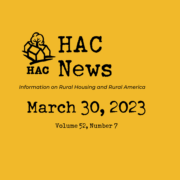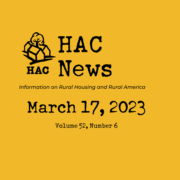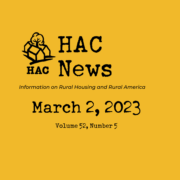TOP STORIES
USDA budget requests growth in rural housing funding
The Biden administration’s budget for fiscal year 2024 would increase resources for almost all of USDA’s rural housing programs. It asks Congress to continue funding the 27,000 Section 521 Rental Assistance units added by pandemic relief legislation and renews proposals made in last year’s budget to improve rental housing preservation by increasing funding and decoupling Rental Assistance from USDA mortgages. It proposes ending subsidy recapture for Section 502 direct borrowers. The Rural Community Development Initiative for capacity building would grow to $22.8 million from $6 million in FY23. HAC’s analysis, as well as a recording and slide deck from HAC’s March 15 budget webinar, are posted online.
HUD budget proposes increased aid to tenants and downpayment assistance
While requesting significant new resources, the administration’s HUD budget would also make small cuts in the SHOP, Section 184 guarantee, and Rural Capacity Building programs. It would increase HOME from $1.5 billion to $1.8 billion, add $565 million for 50,000 new incremental vouchers, and provide $300 million for capital investments in public housing. A new mandatory spending program would provide downpayment assistance. Other proposed mandatory spending – which must be approved by legislation in addition to the annual appropriations bill, and therefore is very unlikely to pass in the current Congress – would add rent aid for specific populations as well as modernizing public housing and financing eviction reduction efforts. HAC’s analysis, as well as a recording and slide deck from HAC’s March 15 budget webinar, are posted online.
Eligible areas under review for rural housing programs
In early March, USDA RD State Offices sent email notices telling stakeholders that the agency is conducting its periodic review of area eligibility designations for its rural housing programs. Based on data from the 2020 census, this review could result in loss of eligibility for some locations. For examples, see these notices from Illinois and Minnesota. Public comments are due in early June, 90 days after the date of each notice. For more information, contact housing staff in an RD State Office.
HAC invites workshop proposals for October 2023 National Rural Housing Conference
HAC requests workshop proposals for its 2023 conference, to be held October 24-27 (with workshops on October 25 and 26) in Washington, DC. The biennial conference brings together rural affordable housing and community development leaders, practitioners, policy makers, funders, industry experts, and partners for learning and networking. Workshops should seek to align themselves with the conference theme – Build Rural – or one of the following threads: Housing Affordability, Development, Preservation, Community Facilities, Rural Prosperity, Placemaking, Capacity Building, Housing Justice, or other adjacent threads. Proposals are due June 2. For more information, contact Kelly Cooney or Diane Hunter, HAC.
RuralSTAT
During the pandemic, domestic migration (moving within the U.S.) to rural areas caused population increases in far more places than before the pandemic: 63% of counties outside metro areas had net population inflows in 2021, compared to only 39% in 2019. Source: Joint Center for Housing Studies.
OPPORTUNITIES
Rural community design support available
The National Endowment for the Arts and HAC, with To Be Done Studio, invite rural communities to apply to the Citizens’ Institute on Rural Design (CIRD) for design support and technical assistance to host an on-site Local Design Workshop or participate in the Design Learning Cohort. Municipal, Tribal, or county governments, local rural nonprofits, rural regional planning organizations, university community design centers or agricultural/extension offices, and partnerships of these entities are eligible. An informational webinar will be offered March 22. Apply by April 21. For more information, contact CIRD, cird@ruralhome.org.
USDA offers Section 515 subsequent loans, info session on March 23
Borrowers with existing Section 515 loans or loan commitments can apply by April 30 for Section 515 subsequent loans to complete, improve, repair, or modify these properties. A second round of funding will be announced later this year. For more information, contact a USDA RD Processing and Report Review Branch (scroll down to the second map to see which branch to contact). USDA will hold a stakeholder information webinar on March 23.
Department of Justice to fund supportive housing and clinical services
The first segment of the Pay for Success grant application process closes on March 21. This grant program will provide six awards in the amount of $1 million each to local, Tribal, or state governments or PHAs for projects providing permanent supportive housing or clinical services for people with mental health, substance use, or co-occurring disorders who are or were involved in the criminal justice system. For more information, contact DOJ’s OJP Response Center, 800-851-3420.
Community Connect broadband grants offered
Nonprofits, for-profits, and state, local, or Tribal governments can apply by June 20 for the Community Connect Grant program to construct broadband networks in rural areas that do not currently have broadband service. For more information, contact Randall Millhiser, USDA, 202-578-6926.
REGULATIONS AND FEDERAL AGENCIES
Revisions proposed for rule on using federal property to assist homeless
HUD, the General Services Administration, and the Department of Health and Human Services are proposing to update the regulations for the Title V program, which allows states or local governments and nonprofits to use some unused federal properties to assist people experiencing homelessness. Comments are due May 19. For more information, contact Juanita Perry, HUD, 202-402-3970.
HUD revises some Fair Market Rents
New FMRs for Hawaii County, HI; Grand Rapids-Wyoming, MI; Hood River County, OR; Wasco County, OR; and Seattle-Bellevue, WA take effect on April 19.
Limited English proficiency requirements repeated for rental housing providers and USDA staff
New USDA guidance reminds agency staff and owners and managers of USDA-financed multifamily housing that they must follow policies and procedures for ensuring that persons with limited English proficiency have meaningful access to USDA’s programs and activities.
EVENTS
HAC plans April workshops
Register for one, two, or all three days of Spring Training (peer networking and practical knowledge), to be held in person in San Diego. There is no registration fee, but space is limited and registration is required. HAC’s annual symposium on “Housing and Services for Rural Veterans” will be on April 11. On April 12 and 13 HAC will present two concurrent trainings, “Leading an Organization in Changing Times” and “Creating Sustainable and Affordable Housing: A Workshop on Green Building Principles.” For more information, contact HAC, 202-842-8600.
National Community Development Week set for April 10-14
This annual observance celebrates improvements achieved with support from the HOME and CDBG programs. Access the National Community Development Week toolkit and other resources online from the CDBG Coalition, which includes HAC.
PUBLICATIONS AND MEDIA
U.S. needs 7.3 million affordable rentals
The National Low Income Housing Coalition’s annual publication, The Gap: A Shortage of Affordable Homes, reports a shortage of 7.3 million affordable and available rental homes for the lowest-income renters in the country. The shortfall increased by 500,000 between 2019 and 2021. Nationwide, there are only 33 affordable and available rental homes for every 100 extremely low-income renter households; among states, the supply ranges from 17 per 100 in Nevada to 58 in South Dakota. The report calls for greater federal investment in the preservation and expansion of the affordable housing stock, more Housing Choice Vouchers, a national housing stabilization fund for renters who experience an unexpected short-term financial shock, and federal tenant protections.
Community organizations address rural homelessness and housing insecurity
Tackling Rural America’s ‘Hidden’ Housing Crisis, an article from the Daily Yonder, describes the work of local groups in rural Oregon and Kentucky to address homelessness and housing insecurity in their areas.
Study compares access to housing voucher waiting lists in and outside of metro areas
Offline: Limited Access to Section 8 Vouchers reports on an Affordable Housing Online analysis of waiting list openings for Section 8 Housing Choice Vouchers from 2016 to 2020. Researchers found that counties outside metropolitan areas were more likely to have lists that remain open indefinitely, while metro counties tended to have waiting lists open for scheduled time periods. Renters were more likely to face barriers accessing Section 8 waiting lists in rural places than in urban areas; for example, their applications were less likely to be online, although overall use of online applications rose by 21% from 2019 to 2020.
Native American credit shortage documented
Native Americans Struggle to Obtain Credit: A Close Analysis of Native American Mortgage Lending From 2018-2021, a National Community Reinvestment Coalition blog post, reports that from 2018 through 2021, just 0.9% of all mortgages in the U.S. went to Native Americans, who make up 3% of the US population. Those who do purchase a home are more likely to choose a manufactured home. Also, mortgage lenders impose higher costs on Native Americans than other groups, even when they are buying less expensive homes. Factors contributing to this state of affairs, the post notes, include a lack of access to credit, discrimination, inadequate affordable housing stock, and a shortage of infrastructure to support development of new homes.
System to protect farmworkers falls short, investigation finds
As part of an ongoing series on farmworker housing, Investigate Midwest published Government System for Protecting Farmworkers Plagued by Staff Turnover and Lack of Outreach. The Monitor Advocate System, a federal-state joint effort, is intended to ensure that states protect farmworkers from unsafe housing, wage theft, and other abuses. Journalists found, however, that some states failed to conduct adequate outreach to farmworkers, employee turnover was high, and during the coronavirus pandemic some states stopped doing outreach at a time when farmworkers likely needed it most.
GAO summarizes ways to improve federal disaster spending
Disaster Assistance: Action Needed to Improve Resilience, Response, and Recovery is a two-page summary of GAO’s recent research and recommendations, released with a blog post and a video, all exploring ways to improve federal disaster recovery, disaster resilience, and the processes for assisting survivors.
HAC
HAC releases 2022 Loan Fund Impact Report
In fiscal year 2022, HAC’s Loan Fund provided $16.6 million of financing so that 36 organizations – including 14 minority-led borrowers – could build, rehabilitate, or preserve 689 affordable homes. More details are available in HAC’s Loan Fund Impact Report.
National Rural Housing Conference set for October
Mark your calendars and save the date! HAC’s National Rural Housing Conference will be held October 24-27 in Washington, DC and online.
Need capital for your affordable housing project?
HAC’s loan fund provides low interest rate loans to support single- and multifamily affordable housing projects for low-income rural residents throughout the U.S. and territories. Capital is available for all types of affordable and mixed-income housing projects, including preservation, new development, farmworker, senior and veteran housing. HAC loan funds can be used for pre-development, site acquisition, site development, construction/rehabilitation and permanent financing. Contact HAC’s loan fund staff at hacloanfund@ruralhome.org, 202-842-8600.
Please note: HAC is not able to offer loans to individuals or families. Borrowers must be nonprofit or for-profit organizations or government entities (including tribes).
Want to reprint a HAC News item?
Please credit the HAC News and provide a link to HAC’s website. Thank you!









